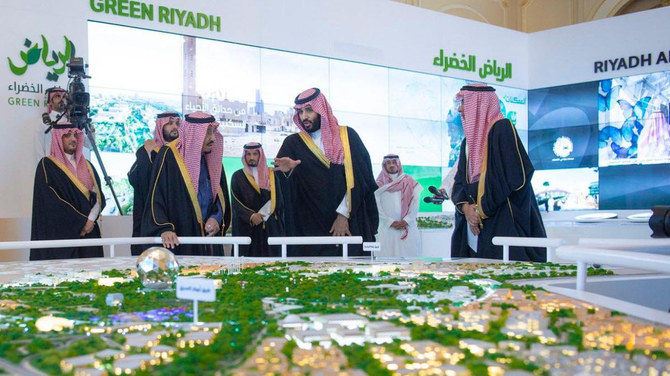The world is getting hotter because of human activities and it is causing problems like heat waves, floods and droughts. The United Nations says we need to cut the pollution that causes this by half in the next 10 years and completely stop it by around 2050.
Many countries, including five in the Gulf Arab region, have promised to do this, but there is still a big gap between what needs to be done and what’s happening now. To reach these goals, we need to use more clean energy, like solar and wind power, and produce things like hydrogen in a cleaner way. It will cost a lot of money, about $2-4 trillion each year, for the next decade to make these changes.
The Gulf Arab countries, even though they produce a lot of oil and gas, can help by using their resources for clean energy. Different organizations have made plans to reach these goals, like using more clean energy and reducing the use of fossil fuels. Even though we need to use less oil, gas and coal, these sources will still be part of our energy use but in smaller amounts. The world needs to act quickly and it depends on factors like political support, available resources and technical abilities. The Gulf Arab states have the potential to make a big difference if they overcome challenges and work towards cleaner energy.
The Gulf Arab states currently have a lot of oil and gas that can last for 20 to 100 years. Even though we expect to keep using these fuels, we want to reduce the pollution they create. We can do this by using technologies like carbon capture, or turning fuels into hydrogen or ammonia which don’t produce harmful emissions.
The Gulf States are trying to invest in cleaner energy, but there is still a big gap between what they’re doing now and what they want to achieve in a pollution-free future. Right now, they have a few facilities that capture carbon dioxide (CO2) but it’s not enough. By 2030, they plan to capture more CO2, produce hydrogen and ammonia and generate cleaner energy. However, they need a lot more renewable energy, about 60 times what they have now, to reach these goals.
The Gulf States have started to work on reducing the impact of climate change by launching various initiatives and programmes even before committing to a pollution-free future. Only Oman and the UAE have made plans for their entire economy to reach net-zero emissions. These plans set goals for each part of their economy to reduce carbon emissions by the middle of the century. However, these plans lack detailed information on how to achieve this in terms of finances, technology and institutions. Other Gulf countries are expected to announce similar plans soon. These plans need to be in line with their economic development and budgets so that economic growth and net-zero goals are not treated as separate issues. This alignment will also help avoid unintended social and economic problems that might come from different climate policies, like carbon pricing.
Five Gulf Arab states, Bahrain, Kuwait, Oman, Saudi Arabia, and the UAE, have committed to achieving net-zero emissions by mid-century. Despite their efforts, it seems that reaching these goals could be challenging without timely and innovative interventions. Without consistent efforts to bridge the gap between current efforts and what is needed for a net-zero future, the region might struggle to realize its ambitions. Implementing climate policies that support net-zero goals will be crucial for economic diversification and to deal with the potential impacts of global climate policies on the region’s oil wealth.
Currently, most climate projects are funded on a case-by-case basis. For example, Saudi Arabia announced a huge investment in cleaner energy and the UAE committed a significant amount of money to achieve its clean energy target. Most of these funds come from selling oil and gas. Except for the UAE, none of the Gulf Cooperation Council states have established a specific framework for climate finance. In 2015, the UAE created the Green Finance and Investment Support Scheme and in 2021, it released the Sustainable Finance Framework (2021-2031) to encourage private sector involvement in sustainable finance. Financial institutions in the UAE are increasingly supporting sustainable and climate-friendly projects.
Oman and the UAE’s national banks have initiated green finance projects, including supporting solar panel installations. Sovereign wealth funds in the region, like Saudi Arabia’s Public Investment Fund, are also actively involved. In 2022, the PIF issued green bonds to raise money for climate and environmental projects. This is part of Saudi Arabia’s efforts to achieve its green goals. As the Gulf countries look towards a future with less reliance on oil, they should start developing and diversifying climate finance instruments to address climate goals.
Nature-based solutions are ways of protecting, restoring or managing natural areas like ecosystems, forests and urban spaces. These methods can help with issues such as food and water security, climate change, disasters and human health. It is believed that by 2050, these nature-based solutions could contribute around 30 percent of the efforts needed to meet the goals of the Paris Agreement and limit global warming.
In the Gulf region, efforts are being made to pursue nature-based solutions such as conserving mangrove ecosystems and planting trees. Saudi Arabia, for example, introduced two initiatives in March 2021, the Saudi Arabia Green Initiative and the Middle East Green Initiative. These aim to plant a large number of trees in Saudi Arabia and across the Middle East, with the goal of significantly increasing tree-covered areas and reducing carbon emissions.
However, because the Gulf region faces water scarcity issues, planting trees might not be the best solution to offset carbon. The suggestion is to explore other options that align better with the natural environment. One such option is carbon capture and mineralization, a process that permanently stores carbon dioxide in specific rock formations called peridotite. This method is cost-effective and suits the arid environment of the Gulf region, which has abundant peridotite rock formations.
Five Gulf Arab states, Bahrain, Kuwait, Oman, Saudi Arabia, and the UAE, have committed to achieving net-zero emissions by mid-century. Despite their efforts, it seems that reaching these goals could be challenging without timely and innovative interventions. Without consistent efforts to bridge the gap between current efforts and what is needed for a net-zero future, the region might struggle to realize its ambitions. Implementing climate policies that support net-zero goals will be crucial for economic diversification and to deal with the potential impacts of global climate policies on the region’s oil wealth.























